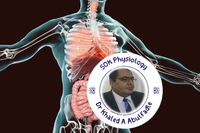admin
Admin

عدد المساهمات : 9700
تاريخ التسجيل : 06/08/2009
 |  موضوع: MCQs on cardiovascular physiology with their answers موضوع: MCQs on cardiovascular physiology with their answers  الخميس أبريل 14, 2011 10:53 am الخميس أبريل 14, 2011 10:53 am | |
| 1) Consider a capillary in which the net driving force for fluid filtration out of the capillary is 0 mm Hg. Capillary oncotic pressure is 26 mm Hg and interstitial fluid oncotic pressure is 4 mm Hg. Which of the following set of capillary hydrostatic pressure and interstitial fluid hydrostatic pressure is consistent with this?
a-15, -6
b-4, 26
c-32, -10
d-29, 7
e-20, 2
2) The smallest diameter of individual blood vessels is in the:
a) Arteries
b) Arterioles
c) Capillaries
d) Venules
e) Veins
3) Which of the following will cause vasodilation?
a) Decreased potassium conductance in vascular smooth muscle
b) Angiotensin II
c) Vasopressin
d) Hyperpolarization of vascular smooth muscle
e) Endothelial cell death
4) During inspiration, which of the following occur?
a) decreased transmural pressure of the right atrium
b) decreased intra-chamber pressure in the right atrium
c) decreased venous return
d) decreased mean volume in the right atrium
e) relaxation of the diaphragm
5) Which of the following will tend to decrease stroke volume?
a) increased end-diastolic volume
b) increased end-systolic volume
c) increased preload
d) increased afterload
e) increased cardiac contractility
6) When a pregnant uterus presses on the abdominal vena cava, which of the following occurs?
a) right atrial pressure increases and femoral (leg) venous pressure increases.
b) right atrial pressure increases and femoral (leg) venous pressure decreases.
c) right atrial pressure decreases and femoral (leg) venous pressure increases.
d) right atrial pressure decreases and femoral (leg) venous pressure decreases.
e) no changes in either right atrial or femoral venous pressures.
7) Which event does occur between the second heart sound and the first heart sound?
a) pulmonary valve is open
b) aortic pressure reaches systolic pressure
c) ventricular ejection
d) isovolumetric ventricular contraction
e) T wave
 Which of the following will increase the firing rate of a pacemaker cell? Which of the following will increase the firing rate of a pacemaker cell?
a) more negative maximum diastolic potential (MDP)
b) less negative threshold potential
c) decreased rate of depolarization of Phase 4
d) increased circulating catecholamines
e) increased vagal efferent tone to the heart
9) The ion which is most permeable across the resting cardiac myocyte membrane.
a) Sodium
b) Potassium
c) Calcium
d) Chloride
e) Protein
10) The ion carrying the major inward current during the upstroke of the nerve action potential.
a) Sodium
b) Potassium
c) Calcium
d) Chloride
e) Protein
11) During a cardiac catheterization procedure, you sample blood from various sites. At which site is the partial pressure of oxygen the lowest (most deoxygenated)?
a) Pulmonary artery
b) Pulmonary vein
c) Left atrium
d) Left ventricle
e) Aorta
12) At which point in the cardiac cycle are the A-V valves open?
a) Rapid filling
b) Isovolumetric contraction
c) Rapid ejection
d) Isovolumetric relaxation
e) None of the above
13) Insufficiency of the aortic valve would cause:
a) Decreased pulse pressure
b) Increased mean arterial pressure
c) Diastolic murmur
d) Decreased arterial oxygen saturation
e) Increased flow to the peripheral tissues
14) If end-diastolic volume were held constant and cardiac contractility were increased, the end-systolic volume would:
a) Increase
b) Stay the same
c) Decrease
d) Not enough information to answer this question.
15) Moderate hemorrhage would tend to cause which of the following (compare to before the hemorrhage)?
a) Increased blood volume
b) Increased parasympathetic tone
c) Increased sympathetic tone
d) Decreased venous constriction
e) Decreased heart rate
16) In a normal fetus, the umbilical-placental blood flows most directly from:
a) Ductus venosus
b) Foramen ovale
c) Ductus arteriosus
d) Aorta
e) Pulmonary artery
17) During the first breath of life:
a) Pulmonary arterial pressure increases
b) Pulmonary venous pressure decreases
c) Left atrial pressure increases
d) Pulmonary vascular resistance increases
e) Foramen ovale flow increases
18) The direct and reflex responses to intravenous injection of arginine vasopressin include which of the following (consider changes relative to before the injection of angiotensin II):
a) increased peripheral resistance and increased heart rate.
b) increased peripheral resistance and decreased heart rate
c) decreased peripheral resistance and increased heart rate
d) decreased peripheral resistance and decreased heart rate
e) no change in peripheral resistance or heart rate
19) The direct and reflex responses to intravenous injection of sodium nitroprusside (a donor of nitric oxide in smooth muscle) include which of the following (consider changes relative to before the injection of nitroprusside):
a) increased peripheral resistance and increased heart rate.
b) increased peripheral resistance and decreased heart rate
c) decreased peripheral resistance and increased heart rate
d) decreased peripheral resistance and decreased heart rate
e) no change in peripheral resistance or heart rate
20) Which of the following will tend to decrease cardiac output?
a) positive pressure (end-expiratory) ventilation (PEEP)
b) myocardial infarction
c) Valsalva Maneuver
d) Aortic valve insufficiency
e) all of the above
Answer
[ندعوك للتسجيل في المنتدى أو التعريف بنفسك لمعاينة هذه الصورة]
         | |
|
